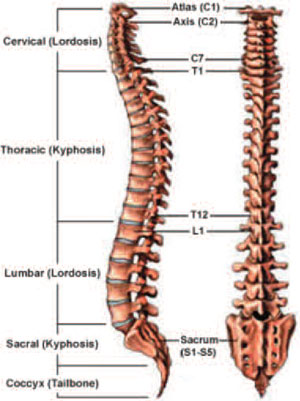Treatment & CareOrthopedicsOrthopedic SurgeryJoint Replacement and Spine CenterThe Spine CenterSpine Surgery - Procedures
Spine Surgery Procedures
 This information is designed to let you know what to expect when undergoing
cervical fusion, lumbar fusion or discectomy.
This information is designed to let you know what to expect when undergoing
cervical fusion, lumbar fusion or discectomy.
The spine is made up of 24 vertebrae separated into sections
- Cervical
- Thoracic
- Lumbar
- Sacral
- Coccyx
There are discs between each vertebrae that help absorb shock.
A healthy spine shelters the spinal cord and supports the Body.
Injuries to the Spine
-
 The vertebrae can be injured by strong forces (ie. fall or trauma) or by
repetitive stress that eventually weakens them.
The vertebrae can be injured by strong forces (ie. fall or trauma) or by
repetitive stress that eventually weakens them.
- Each disc between the vertebrae has a jelly-like center and tough outer ring.
- Herniated Disc: As the disc degenerates it loses flexibility and causes the inner jelly and outer ring to bulge.
- Ruptured Disc: Too much pressure can cause the inner jelly to squeeze through.
- Common signs/symptoms: Numbness, pain, weakness.
Your Surgery: Cervical Fusion
- A disc(s) between one or more vertebrae is removed to remove pressure on the nerve or spinal cord. To prevent the vertebrae from rubbing together a bone graft is placed between them.
- Hardware and bone graft are used. The hardware provides support while the bone grafts slowly fuse.
- Bone graft can be taken from your own iliac crest (pelvic bone) OR from a cadaver.
- Most common approach is the anterior approach through the front of the neck.
- The surgery will take about two to four hours.
Your Surgery: Discectomy
- Most common surgery used to treat a ruptured or herniated disc.
- A piece of the disc or entire disc between the two vertebrae is removed to alleviate the pressure on the nerve causing the pain, weakness, or numbness.
- The surgeon may use a microscope to perform the procedure (microdiscectomy).
- You will enter/exit the OR laying on your back but will be placed on your abdomen during the procedure.
Your Surgery: Lumbar Fusion
-
 A disc(s) between one or more vertebrae is removed to remove pressure on
the nerve or spinal cord. To prevent the vertebrae from rubbing together
a bone graft is placed between them.
A disc(s) between one or more vertebrae is removed to remove pressure on
the nerve or spinal cord. To prevent the vertebrae from rubbing together
a bone graft is placed between them.
- Hardware and bone graft are used. The hardware provides support while the bone grafts slowly fuse.
- Bone graft can be taken from your own iliac crest (pelvic bone) OR from a cadaver
- Based on the surgery the spine will be accessed through the posterior (back), anterior (front) or lateral (side) approach.
- You will enter/exit the OR on your back but will be placed on your abdomen for most of your surgery.



